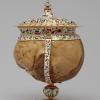Ewer formed from a Seychelles nut, Prague, 1602
Commentary
Ewer formed from a Seychelles nut, Prague, 1602
Origin. Perhaps the most extravagant of all these artificially enhanced natural objects is this ewer or pitcher made for Rudolf from a Seychelles nut in Prague in 1602. The Seychelles nut is in fact a great rarity even today, and an account of its origin helps explain why a natural curiosity was treated in such extraordinary fashion in the early seventeenth century.
The Seychelles is an archipelago of 115 islands, in the Indian Ocean about 1,500 kilometres east of mainland East Africa. The ‘Seychelles nut’ is the fruit a monotypic genus in the palm family, Lodoicea. A monotypic genus is a genus with only one species, in this case known as Lodoicea maldivica. So this is a very peculiar naturaliumeven today, and it is also very rare because the species is endemic on only two small islands of the Seychelles archipelago: Praslin and Curieuse. Since these islands were uninhabited and virtually unknown before the 1740s, the origin of the Seychelles nut remained a complete mystery during the seventeenth century.
The rarity and restricted habitat of this plant derive from the extraordinary qualities of its huge seeds. The fruit of the Lodoicea maldivica, which takes six or seven years to mature, is the heaviest fruit so far recorded in the wild, weighing up to 42 kg. The mature seeds within that fruit are also the world’s heaviest, weighing up to 17.6 kg. When one of these fruits falls into the sea, its great weight and density mean that it sinks straight to the bottom. After a considerable period on the seabed, however, the husk falls away, the internal parts of the nut decay, and gases forming inside cause the nut to rise to the surface. By this time, the nut is infertile, which explains why the species is trapped on a couple of small islands. But the dense nuts can drift for thousands of kilometres on ocean currents without decaying further and were known and prized in medieval times in many parts of the Indian Ocean.
Significance. So this nut, sheathed in gold and silver, is a piece of flotsam, found bobbing on the waves or washed up on the shores of the world's third largest ocean. And its unknown origins added to its value: it was like a mysterious message from nowhere, from utopia, from a world not merely exotic or outlandish but completely unknown -- just the kind of thing to inflame the passions of a sixteenth-century collector.
Its value to the collector was enhanced further by the myths which had filled the gaps in local knowledge. Seamen from the Malaysia – over 5,000 kilometres away – occasionally observed coco de mer nuts ‘falling upwards’ from the sea floor. From this they concluded that these nuts must grow on underwater trees, in a forest at the bottom of the Indian Ocean. Hence the name ‘sea coconut’, from the French ‘coco de mer’, which is still commonly used today. New worlds had been discovered during the previous century, and whole continents remained to be discovered in the next one. Who was to say that there was not an undersea world in which coconuts fell upwards from submarine palm trees? This speculation is not nearly as extravagant as innumerable things photographed in the deep ocean for the first time recently, including whole ecosystems previously unimagined by modern biological science.
Early European explorers communicated this lore to eager readers back home. João de Barros (1496–1570), the first great historian of Portuguese exploits in Asia, added testimony regarding the healing properties to the coco de mer, which he thought to be superior even to those of ‘the precious stone Bezoar’. Local peoples prized it accordingly. In the Maldives (a mere 2,000 kilometres east of the Seychelles), any ‘sea coconut’ found in the ocean or on the shore was regarded as the property of the king, and anyone withholding such a nut for himself or selling it to another could face the death penalty.
Rudolf II nevertheless managed to purchase one for the vast sum of 4,000 gold florins. Hence the exquisite craftsmanship deployed in creating the marine images which dominate the work: Neptune rides a hippocampi on the lid (his trident missing); two back-to-back tritons carry the pitcher (which has been hollowed out to carry liquid); the half-nut forms the shape of a ship, with further maritime motifs carved into its the surface.
Commentary. Howard Hotson (May 2018)
Literature. Kunsthistorisches Museum, Prag um 1600: Kunst und Kultur am Hofe Rudolfs II, 2 vols (Freren, 1988), vol. 1, no. 340; E. Scheicher, 'Zur Ikonologie Naturalien im Zusammenhang der enzyklopädischen Kunstkammer', Anzeiger des Germanischen Nationalmuseums (1995), pp. 115-25; Sabine Haag and Franz Kirchweger, eds., Treasures of the Habsburgs (London, 2013), pp. 200-1.

